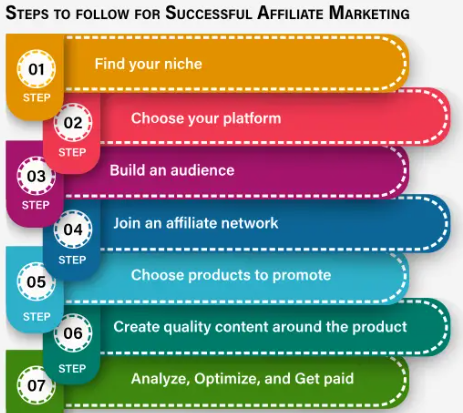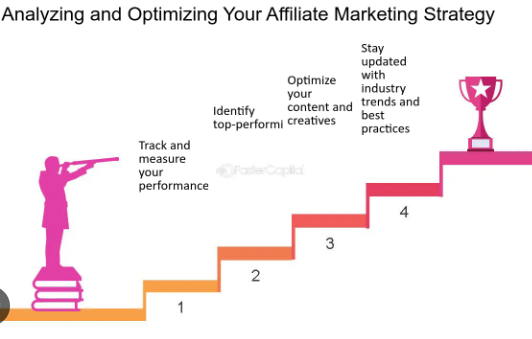
I’m going to let you in on a not-so-secret secret: affiliate marketing has become a powerhouse in the realm of digital commerce. Imagine earning from a blog, video, or social media post. That’s affiliate marketing for you. It’s about promoting products and earning a commission for each sale through your unique affiliate link.
This isn’t just about making money online; it’s also about building a relationship between you, the content creator, and your audience. With its relatively low barrier to entry, affiliate marketing opens doors for budding entrepreneurs to potentially generate passive income.
Now, you might be thinking, ‘Can I really make money with this?’ You’re going to find out about key strategies that can turn your affiliate marketing efforts from mere hobby to a substantial income. But remember, success doesn’t happen overnight. It’s a journey—one that begins with understanding the basics and setting solid goals. Which leads me to the next part…
In the upcoming section, I’m here to help you set clear, attainable goals for your affiliate marketing business. We’ll explore how to identify a profitable niche that aligns with your passions and interests and delve into expectations that will guide you towards achieving real, tangible results. It’s time to get started on this promising venture with a firm ground beneath your feet.
Setting Your Affiliate Marketing Goals

You’re going to find out about the importance of carving out your own niche in the vast world of affiliate marketing. Choosing the right niche is crucial because it needs to strike a balance between what you’re passionate about and what has the potential to generate revenue. It’s not enough to just pick a topic you love; if it doesn’t have a demand in the market, it might not be profitable. Conversely, a high-demand, high-competition niche may be challenging to break into.
Next, let’s talk setting expectations. When you’re just starting out, it can be easy to fall for claims of quick and effortless profits. But in my opinion, it’s critical to set realistic goals and be patient. Affiliate marketing is a marathon, not a sprint. Develop your roadmap with clear milestones. This won’t just guide your efforts, but also help maintain motivation as you reach smaller objectives on the way to larger ones.
Lastly, consider the trajectory of your affiliate marketing pursuit. Are you looking for a short-term hustle or a long-term career? This will dictate the strategies you implement. Short-term tactics might bring in quick cash but often involve greater risk and less sustainability. Long-term strategies, however, require building a strong foundation, consistency, and a focus on building relationships with your audience and partners.

Understanding Different Affiliate Marketing Platforms

A key step in becoming a successful affiliate marketer is picking the right platform. Think of it as finding a new favorite coffee shop; you want one that has the blend you like, feels comfortable, and keeps you coming back for more.
For starters, you’re going to find out about some heavyweight champions in this arena. The Amazon Associates program, for instance, offers access to a vast array of products but comes with lower commission rates and shorter cookie durations. ClickBank, on the other hand, focuses on digital goods with typically higher commission rates. ShareASale has a diverse mix of both digital and physical products, providing a balanced choice.
But choosing a platform isn’t as simple as picking the one with the highest commissions. You should consider the relevance to your niche, the support offered by the network, and the reliability of their tracking systems.
In my opinion, the best platforms are the ones that align with your audience’s preferences and trust. If your audience is tech-savvy, a platform specializing in the latest gadgets might be just the ticket. If they’re artists or DIY enthusiasts, a network with crafting supplies or digital art tools could be a better fit.
So, after selecting a platform that resonates with you and your audience, it’s time to craft a space that your followers can trust. That’s what the next section is all about.
Creating a Trustworthy Affiliate Marketing Platform

You’ve got your sights set on the different platforms, and now it’s time to talk about the foundation of your affiliate marketing efforts: your own platform. Whether it’s a blog, YouTube channel, or podcast, creating a dependable home base is critical. But it’s not just about having a space to put your affiliate links; it’s about building trust with your audience.
When it comes to content, quality is king. You’re going to find out about providing value first and selling second. That means your content should educate, entertain, or solve problems for your audience. Don’t just push products; share stories, experiences, and genuine recommendations. Remember, successful affiliate marketing is rooted in credibility.
In my opinion, consistency is also vital. Posting regular, high-quality content goes hand in hand with trust. It signals to your audience and search engines alike that you’re a reliable source of information. Plus, it keeps your audience coming back for more, which is essential for building a loyal following.
Now, let’s not forget about compliance. You must adhere to the Federal Trade Commission’s guidelines, making sure to disclose your affiliate relationships upfront. Be transparent about the fact that you’re earning a commission. This isn’t just about following the law; it’s also about maintaining the trust you’ve worked hard to establish.
Once you have a trustworthy affiliate marketing platform, it’s time to think about how to get people to visit. That’s where driving traffic to your site enters the picture. And I’m not just talking about any traffic; you want targeted, interested visitors who are more likely to engage with your affiliate offers.
How do you attract the right visitors? That’s going to include a solid understanding of SEO practices, engaging on social media platforms, and a tailored email marketing strategy, which I’ll delve into in the next section. Those are your tools for building a bridge between your content and the audience out there searching for it.
Driving Traffic to Your Affiliate Content

Getting people to see and engage with your affiliate content is crucial for success. I’m going to walk you through some tried and true strategies for drawing in a crowd.
Let’s start with the backbone of online visibility: SEO, or search engine optimization. You’re going to find out about tailoring your blog posts or videos to what people are searching for, using keyword research tools to find terms your audience uses, and optimizing your content to rank well in search engine results.
Next, we’ll tap into the power of social media. Choose platforms where your target audience hangs out. Share your content, engage with users, and utilize social media advertising to boost your reach. Remember, social media is not just a broadcast channel; it’s a two-way street meant for genuine interaction.
Last but certainly not least is email marketing. Collecting emails through your content platform gives you direct access to your audience. I’ll show you how to nurture these leads by providing additional value in your emails and gently guiding them toward your affiliate offers. It’s all about building relationships, not just blasting sales pitches.
Now, after you’ve started driving more traffic to your affiliate content, you’ll need to track your results and optimize your methods. That’s where we’re headed next. In our upcoming section about analyzing and optimizing your affiliate strategy, you’ll learn about making data-driven decisions to fine-tune your approach and increase your earnings.
Analyzing and Optimizing Your Affiliate Strategy

Alright, you’ve set up your affiliate marketing game, and you’re driving traffic to your killer content. But the work doesn’t stop there. Your journey to becoming an affiliate marketing pro is all about fine-tuning.
Start by keeping a close eye on your performance data. Which articles are getting the most clicks? Which links are converting to actual sales? Use tools like Google Analytics to track this information and understand user behavior.
Now, here’s where the magic happens: A/B testing. Play around with different headlines, calls-to-action, and images to see what resonates best with your audience. It’s all about creating that perfect recipe that makes your readers click and buy.
Things not going as expected? Don’t be afraid to pivot your strategy. Sometimes the niche you chose or the platform you’re using just isn’t the right fit. That’s totally fine. I want you to remember: your first attempt doesn’t need to be your last.
And if you ever hit a roadblock, consider reaching out for guidance. There are plenty of affiliate marketing veterans out there who offer courses, write books, or can coach you one-on-one.
Remember, this is a learning experience. Choose something that resonates with you, keep testing and improving, and you’ll see your affiliate marketing efforts bear fruit. I really hope that you found this guide useful, and I’m here to help you with any questions you might have as you get your affiliate empire off the ground. Good luck!


Well-crafted article, in my opinion learning affiliate marketing as a beginner can be both exciting and challenging. It’s essential to start with a solid understanding of the basics—how affiliate marketing works, selecting the right niche, and choosing reliable affiliate programs. Success in affiliate marketing often requires a mix of skills, including content creation, SEO, and digital marketing. Beginners should focus on building a strong online presence and understanding their audience’s needs. With persistence and a willingness to learn, affiliate marketing can be a profitable venture, but it’s important to approach it with realistic expectations and a commitment to continuous learning. Thanks.